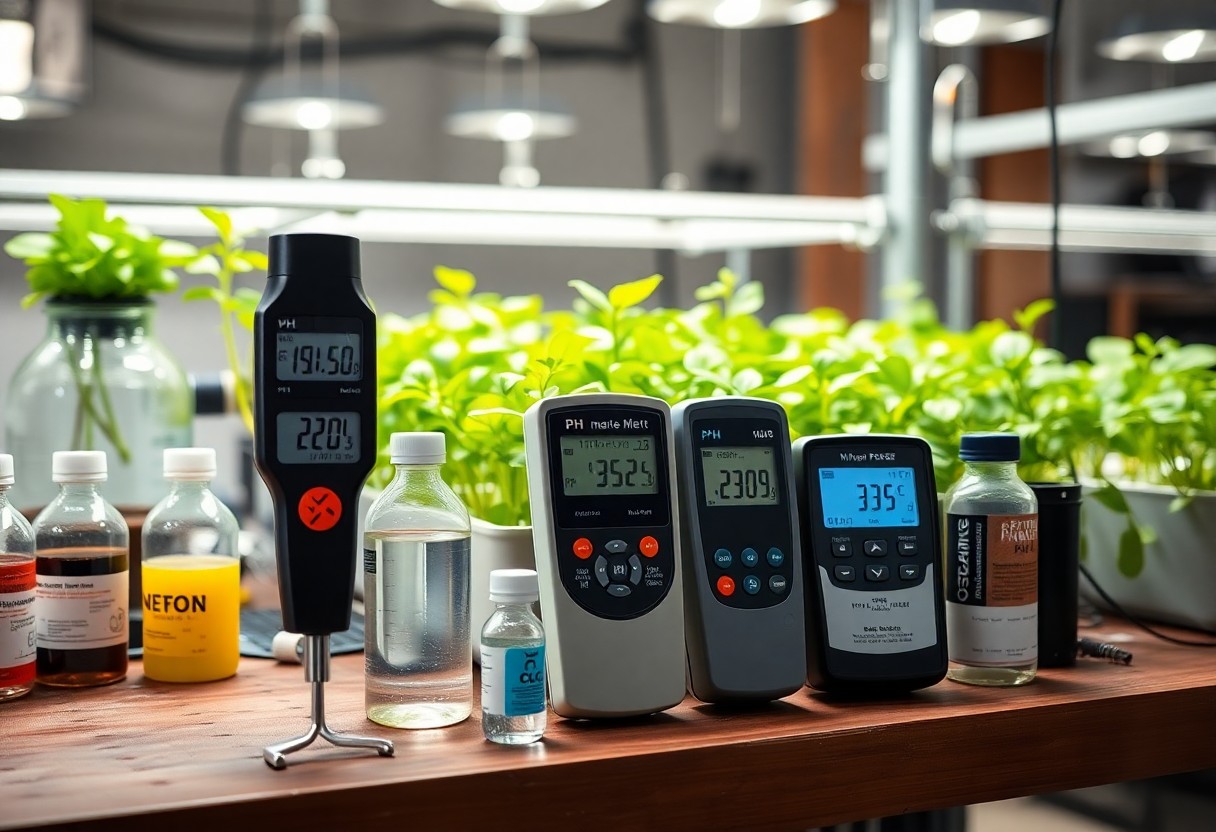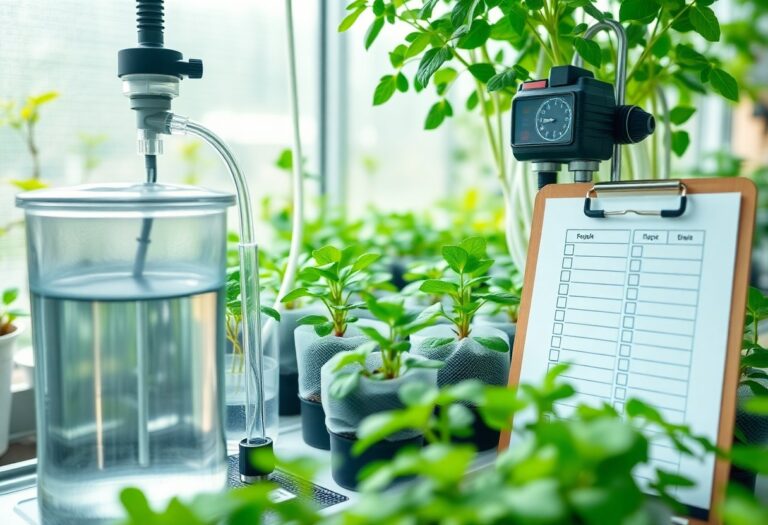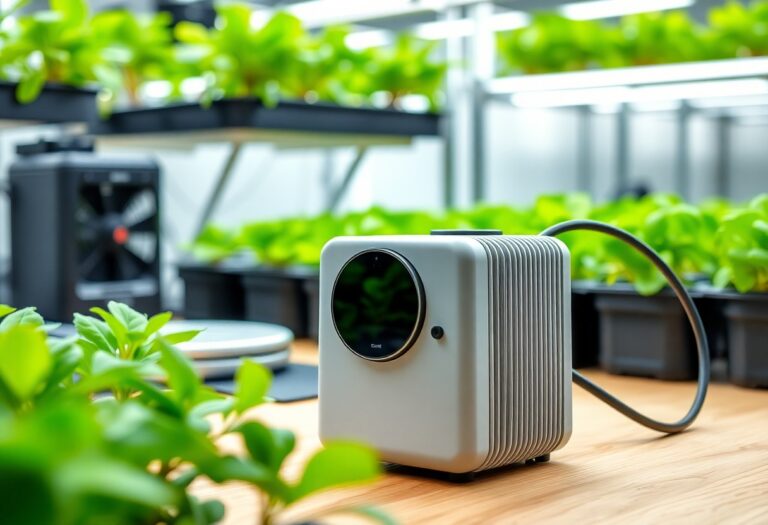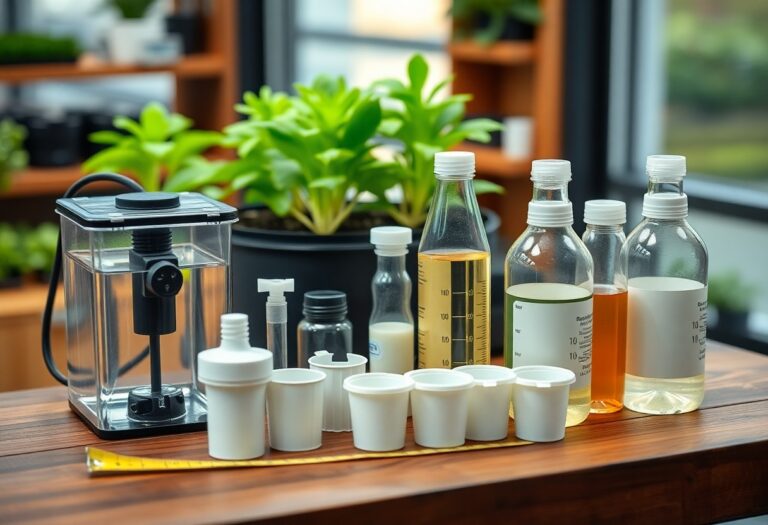They should consider the importance of a reliable pH meter when managing nutrient levels in hydroponic systems, particularly in Deep Water Culture (DWC) setups. A precise pH meter can significantly impact plant health, ensuring optimal nutrient absorption. By assessing features such as accuracy, ease of use, and response time, growers can make informed decisions. This guide will explore top picks specifically designed for hydroponics, assisting enthusiasts in achieving thriving crops.
Key Takeaways:
- Select a pH meter that offers a quick response time for efficient monitoring of nutrient solutions in hydroponic systems.
- Look for a pH meter with automatic temperature compensation to ensure accurate readings across varying temperatures.
- Choose a model with a sturdy and waterproof design, as hydroponic environments can be humid and messy.
- Consider a meter with interchangeable probes to easily replace worn-out components without purchasing a new device.
- Invest in a pH meter that includes calibration solutions or is easy to calibrate for long-term reliability and performance.

The Essential Role of pH in Hydroponic Success
Exploring the Chemistry: pH and Nutrient Availability
In hydroponics, nutrient uptake is tightly linked to pH, which impacts the solubility of important minerals. For instance, elements like iron and manganese become increasingly available at lower pH levels, while calcium and magnesium tend to be more accessible at higher pH. This relationship underscores the need for growers to maintain pH levels between 5.5 and 6.5 for optimal nutrient absorption. Straying outside of this range can lead to significant deficiencies or toxicities. A study demonstrated that plants experiencing pH imbalances exhibited stunted growth, reduced yields, and even severe nutrient lockout.
By contrast, balancing pH effectively allows for a vibrant nutrient reservoir, enabling plants to absorb the minerals they need to thrive. Growers who monitor their pH levels closely often report enhanced primary and secondary metabolic processes, improving overall plant vigor and resilience. As such, understanding the chemistry behind pH and nutrient availability plays a vital role in a hydroponic grower’s toolkit.
The Impact of pH Fluctuations on Plant Health
pH fluctuations can create a ripple effect through a hydroponic system, leading to detrimental consequences for plant health. For example, a sudden drop in pH can shock plants, inhibiting root function and slowing growth rates. Conversely, an abrupt increase in pH introduces the risk of nutrient lockout, where plants are unable to access vital nutrients even if they are present in the solution. Growers may find evidence of these issues manifested as leaf discoloration, wilting, or diminished fruit set.
In a well-documented case, a commercial hydroponic operation experienced significant losses when pH levels fluctuated wildly, resulting in a 30% reduction in yield. Monitoring and adjusting pH can prevent such losses, ensuring that plants receive consistent nutrition. Moreover, some growers employ advanced pH buffering agents, aiding in stabilizing their hydroponic environment and keeping conditions favorable for cultivation.
Key Features to Consider When Selecting a pH Meter
Choosing the right pH meter involves examining several key features that can significantly affect performance and convenience. Buyers should evaluate:- Calibration and Accuracy: A reliable pH meter will offer multiple calibration points to ensure precision readings.
- Sensor Type: The type of sensor can impact accuracy and durability. Options usually include glass and non-glass electrodes.
- Readability and Display: A clear, straightforward display is necessary for quick reading and interpretation.
- Durability and Waterproofing: A pH meter that is water-resistant or fully waterproof can withstand the hydroponic environment more effectively.
- Battery Life: Long-lasting battery life enhances usability, particularly in larger systems where recharging may be inconvenient.
Calibration and Accuracy: Why Precision Matters
Calibration is integral to maintaining the accuracy of a pH meter, particularly in hydroponic systems where imprecision can lead to nutrient deficiencies or toxicities. Many high-quality meters allow for calibration with at least two standard solutions, improving their overall accuracy. He or she should expect to recalibrate regularly—every few weeks or whenever significant changes in temperature or water chemistry occur—to keep measurements consistent. With precision being vital for optimal plant health, calibration directly influences outcomes in a hydroponics setup. A meter that allows custom calibration points tailored to specific nutrient solutions provides an advantageous edge, ensuring that the readings reflect the true state of the solution.Sensor Type: Glass vs. Non-Glass Electrodes
The type of sensor used in a pH meter is crucial in determining its performance and longevity. Glass electrodes, which are commonly used, provide high accuracy and a fast response. These sensors are sensitive to pH changes, making them suitable for various nutrient solutions found in hydroponics. However, their fragility is a downside, as they can easily break if mishandled. Non-glass electrodes, on the other hand, tend to be more durable and resistant to damage. While they may not provide the same level of precision as glass sensors, advances in technology have improved their accuracy substantially. They are often preferred for environments where durability is paramount, such as in outdoor or commercial hydroponic systems.Readability and Display: User-Friendly Metrics
User-friendly readability is necessary for efficiently monitoring pH levels. A digital display with large, easy-to-read numbers can make a profound difference, especially in low-light conditions. Backlit screens or color-coded displays enhance visibility, reducing the potential for misinterpretation of readings. High-end models may also offer data logging features, allowing users to track pH changes over time. This feature can be beneficial for users conducting experiments or those who want to maintain optimal nutrient solutions. Moreover, models that provide a graphic representation of data trends allow for comprehensive assessment over extended periods.Durability and Waterproofing: Tools for the Garden
Durability plays a key role in selecting a pH meter, particularly where frequent handling and use in aquatic environments are concerned. Hydroponics can expose meters to moisture, and choosing a waterproof model is advisable to prevent damage. Quality meters can withstand splashes, humidity, and occasional drips without compromising performance. Furthermore, some meters come with protective cases or reinforced designs that resist impacts, adding to their longevity. These features ensure that even in a busy working environment, such as a greenhouse or a production facility, the meter remains functional and accurate under daily wear and tear. By considering these necessary features, he or she can confidently select a pH meter that suits their hydroponic system’s needs, enhancing overall plant health and yield.Navigating Budget Constraints: Finding Quality in Affordability
High-End vs. Budget Models: Is the Price Justified?
Investing in a high-end pH meter often comes with a plethora of features that promise improved accuracy and reliability. Models from renowned brands can exceed prices of $200 or more, showcasing advanced technology like automatic temperature compensation and faster response times. However, for hobbyists and those new to hydroponics, these premium features may not be fully utilized. He or she might question whether the additional cost correlates with tangible benefits or if they could achieve satisfactory results with a budget-friendly alternative that may range between $20 to $75.
On the flip side, budget models may lack some advanced capabilities such as auto-calibration or digital displays, but many can still deliver adequate performance for maintaining DWC systems. Specific models, like the Bluelab pH Pen, have garnered positive reviews for striking a balance of functionality and price. Ultimately, discerning growers must weigh their specific needs and experience level against the price tag of high-end options; the answer may not always be as clear-cut as it appears.
Best Entry-Level pH Meters for Beginners in DWC
For those stepping into hydroponics, entry-level pH meters serve as accessible tools without compromising on basic functionality. Options such as the Apera Instruments AI209 and the VIVOSUN pH Meter are popular among beginners for their ease of use and affordability, typically costing between $25 and $50. These meters generally come with straightforward calibration processes and provide vital features necessary for managing nutrient solutions in Deep Water Culture setups.
Both models highlight robust accuracy along with managed maintenance, allowing new growers to focus on cultivating plants rather than troubleshooting complex equipment. Equipped with user-friendly instructions, these meters help establish a foundational understanding of pH management critical for plant health in hydroponics.

The Cream of the Crop: Our Top Recommendations
Best Overall pH Meter: The All-Rounder
The Bluelab pH Pen deserves recognition as the best overall pH meter for hydroponics. This handheld model combines affordability with functionality, making it an ideal option for beginners and seasoned growers alike. Features such as automatic temperature compensation and a backlit display enhance usability, enabling users to accurately monitor and adjust nutrient solutions in deep water culture (DWC) systems with ease. Its waterproof design allows for seamless operation in various hydroponic setups, providing peace of mind during intense grow cycles.
This pen-style meter offers a quick calibration process, a feat that is often a stumbling block for many users. With a measurement range of 0 to 14 pH and an impressive accuracy of ±0.1 pH, growers can confidently tweak their nutrient solutions, ensuring optimal plant health and growth. As a trusted name in the hydroponics community, the Bluelab pH Pen remains a top choice due to its reliability and superior performance.
Best for Professionals: Premium Picks with Precision
For hydroponic professionals seeking the pinnacle of accuracy, the Apera Instruments AI209 offers unparalleled precision and advanced features. This high-end pH meter boasts an accuracy rate of ±0.01 pH, catering specifically to demanding agricultural applications. With a large, clear LCD screen and ergonomic design, it allows for comfortable, long-term use in the most challenging environments, making it a favorite among expert growers.
The AI209 also includes a data logging function that records the last 500 measurements, enabling detailed tracking of pH levels over time. The long-lasting electrode and robust construction assure users of longevity, a significant consideration when investing in a professional-grade instrument. Its ability to handle extreme pH levels and harsh conditions further establishes the Apera Instruments AI209 as a top-tier option for hydroponics experts.
In addition to its precision, the Apera AI209 is equipped with a temperature sensor, ensuring accurate readings across a wide range of environmental conditions. This feature is particularly beneficial for those managing complex DWC setups with fluctuating temperatures that might otherwise affect pH levels. It is an investment that assures professionals of performance reliability and helps them achieve the results they aim for in their hydroponic systems.
Best Budget Option: Quality Representation Under $50
The HH pH-009 is an outstanding budget-friendly pH meter that maintains crucial functionalities without breaking the bank. Priced typically under $50, this device features a straightforward design, perfect for hobbyists or newcomers to hydroponics. It measures pH levels from 0 to 14, with a tolerance of ±0.1 pH, ensuring that users can maintain their nutrient solutions within the ideal range.
Furthermore, the HH pH-009 is equipped with a replaceable electrode, making it a practical investment for those who seek sustainability over time. Its compact size and simple calibration process add to its appeal, allowing users to effectively monitor pH levels without excessive complexity. This affordability ensures that new growers can enter the world of hydroponics without a significant financial commitment while still obtaining reliable results.
Offering remarkable performance at an economical price, the HH pH-009 stands out as a reliable choice for those operating on a tight budget. With its user-friendly interface and dependable accuracy, even beginners can confidently adjust their hydroponic systems, setting the stage for a fruitful growing experience. This combination of quality and affordability elevates the HH pH-009 as the go-to pH meter for aspiring hydroponic enthusiasts.
Proper Maintenance and Calibration: Extending Your Meter’s Lifespan
Routine Cleaning: Maintaining Accuracy Over Time
Regular cleaning of a pH meter is imperative for maintaining its accuracy and ensuring reliable readings. He should gently rinse the probe with distilled water after each use. Residual nutrients, salts, or contaminants can accumulate and interfere with the probe’s ability to provide precise measurements. It’s advisable to use a soft, lint-free cloth to wipe down the sensor and the housing to avoid scratches that could affect the instrument’s performance.
For deeper cleaning, particularly if there are stubborn residues, a mild pH 4 or pH 7 buffer solution can be employed. Soaking the electrode in this solution for a few minutes helps in dissolving any contaminants that cling to it. After cleaning, the probe should again be rinsed with distilled water to eliminate any cleaning solution residue, ensuring that the next measurement is as accurate as possible.
Step-by-Step Calibration Process: Ensuring Optimal Performance
The calibration of a pH meter is a straightforward, yet imperative, procedure for ensuring that readings reflect true pH levels in a hydroponic system. Typically, this process involves using at least two pH buffer solutions, such as pH 4 and pH 7, to calibrate the meter accurately at multiple points. He should first immerse the electrode in the first buffer solution until the reading stabilizes, followed by adjusting the readout according to the buffer specification.
| 1. Prepare Calibration Solutions | Use fresh pH buffer solutions (usually pH 4 and pH 7). |
| 2. Rinse the Probe | Flush the probe with distilled water to avoid contamination. |
| 3. Immerse in First Buffer | Place the probe in the first buffer; wait for the reading to stabilize. |
| 4. Set Calibration Point | Adjust the meter to match the pH of the first buffer. |
| 5. Repeat with Second Buffer | Rinse the probe, then immerse it in the second buffer and repeat the adjustment. |
This step-by-step calibration process enhances the performance and longevity of the pH meter. Regular calibration (ideally before each use or at least weekly) ensures that the readings remain trustworthy, especially in a dynamic environment like hydroponics, where pH levels can shift unexpectedly. They can keep a log of calibration sessions to monitor how often adjustments are needed, which highlights any potential wear or issues with the probe over time.
| Frequency of Calibration | After each use or at least once a week. |
| Signs of Probe Wear | Frequent calibration adjustments, slow response, or erratic readings. |

Real-world Applications: Insights from Hydroponic Experts
Interviews with Successful Hydroponic Growers
In a recent interview with a seasoned hydroponic grower, Jeff, who has been cultivating produce in a deep water culture (DWC) system for over five years, shared his experiences regarding pH management. He emphasized that maintaining the pH level between 5.5 and 6.5 was vital for nutrient absorption, claiming, “If the pH drifts outside that range, I can see the stress in my plants within 24 hours.” Jeff elaborated on how he utilizes the Bluelab pH Pen for its rapid readings, allowing him to make adjustments quickly whenever necessary. He consistently checks his nutrient solution throughout the week, allowing for precise tailoring of nutrient mixes. Another hydroponic farmer, Sarah, highlighted the importance of calibrating her pH meter every month. She noted that her early struggles stemmed from not taking the time to calibrate properly. “A small error in calibration led to nutrient lockout during my first year,” she recalled. Now, she adheres to a strict schedule, often sharing her calibration insights with beginner growers in her community. Sarah’s methodical approach underscores the advantages of investing in the right pH meter, stating, “It has made all the difference in my yield and quality of produce.”Lessons Learned: Stories of Trial and Error
Sharing her journey, Emily recounted the pivotal moment when her pH meter malfunctioned, causing her to lose an entire crop of lettuce. The incident pushed her to invest in a higher-quality meter, which not only provided more reliable readings but also came with helpful customer support. “I didn’t realize pH management would be such a challenge. That loss motivated me to really understand the science behind hydroponics,” she explained. For her, learning to connect the dots between nutrient absorption and pH levels was necessary in improving her growing practices. Several growers have also emphasized documenting their growing trials. By maintaining a detailed log of pH readings, nutrient strategies, and changes in plant health, they have been able to correlate specific adjustments with growth outcomes. This practice has not only refined their expertise but has also fostered a sense of community as they share tips and experiences with fellow growers about the repercussions of neglecting pH management. Understanding the stories shared by these successful hydroponic growers highlights the significant impact of proper pH management in hydroponic systems. Whether it’s from investing in superior equipment or maintaining diligent records, the lesson rings clear: learning from failures leads to greater success in the world of hydroponics.Adapting Your pH Meter to Changing Hydroponic Environments
Seasonal Adjustments: Modifying Care in Different Conditions
Hydroponic growers face varying challenges as seasons shift. During warmer months, they might notice an increase in evaporation rates, which can lead to concentrated nutrient solutions and adjustments in pH readings. This fluctuation may necessitate more frequent monitoring and adjustments to maintain optimal conditions for plant growth. For instance, a rise in temperature could increase metabolic rates in plants, pushing them to demand nutrients at a higher rate, thereby influencing the hydroponic solution’s pH level.
In contrast, colder months often lead to reduced light levels and slower plant growth, resulting in smaller fluctuations in pH. However, growers should remain vigilant as nutrient uptake decreases may cause certain elements to accumulate, potentially altering the pH balance in unexpected ways. Regular monitoring during these transitional periods allows growers to fine-tune their systems effectively, ensuring that plants thrive regardless of the external environment.
Upgrading Gear: When and Why to Consider a New Meter
Eventually, even the best pH meters can become outdated or less reliable due to wear and tear. Signs that it may be time for an upgrade include inconsistent readings, the meter not stabilizing as quickly as it once did, or an inability to calibrate properly. For instance, a meter that initially provided accurate readings but now exhibits variance could lead to poor plant health if unaddressed. Regular evaluation of gear performance is necessary for maintaining optimal hydroponic conditions.
Investing in a new pH meter not only enhances accuracy but also often includes advanced features such as Bluetooth connectivity, automatic temperature compensation, and data logging capabilities. These upgrades streamline the monitoring process, allowing growers to gather and analyze data over time, which can lead to informed decisions about nutrient management. They may also offer improved sensor technology that extends the lifespan of the equipment, making it a cost-effective choice in the long run.
Summing up
Summing up, selecting the appropriate pH meter for hydroponics, particularly in Deep Water Culture (DWC) systems, is crucial for ensuring optimal plant health and growth. Individuals engaged in hydroponics should consider accuracy, ease of use, and calibration features when evaluating their options. High-quality pH meters provide reliable readings, which are vital for maintaining the ideal pH levels in nutrient solutions. Brand reputation, customer reviews, and available support can also inform their choices, making the process of selection manageable.
In the landscape of hydroponics, the right pH meter acts as a valuable tool for those cultivating crops in a soilless environment. With a variety of options available, individuals can find a meter that aligns with their specific needs and budget considerations. By investing in a suitable pH meter, they enhance their ability to monitor and adjust nutrient solutions, fostering healthy plant development and ultimately leading to successful yields. A thoughtful choice in equipment underscores their commitment to achieving excellence in hydroponic cultivation.
FAQ
Q: Why is pH important in hydroponics?
A: pH is a key factor in hydroponics as it affects nutrient availability in the solution. Most plants absorb nutrients efficiently at a pH range of 5.5 to 6.5. If the pH falls outside this range, plants may struggle to uptake necessary nutrients, leading to deficiencies or toxicities.
Q: What features should I look for in a pH meter for hydroponics?
A: When choosing a pH meter for hydroponics, consider features such as accuracy, calibration options, range of measurement, sensitivity, and durability. Additionally, opt for a meter with a clear display and an easy-to-use interface to simplify your monitoring process.
Q: Is it beneficial to choose a pH meter with automatic calibration?
A: Yes, a pH meter with automatic calibration can save time and ensure accuracy. This feature can help maintain the meter’s precision over time, allowing for consistent readings without the need for manual calibration, which can be complex and time-consuming.
Q: Can I use a standard pH meter for my DWC system?
A: While you can technically use a standard pH meter, it is advisable to invest in one specifically designed for hydroponics or DWC systems. These specialized meters often provide better accuracy in nutrient solutions and are built to withstand the specific conditions found in hydroponic environments.
Q: What are some top brands recommended for pH meters in hydroponics?
A: Some reputable brands for pH meters in hydroponics include Hanna Instruments, Bluelab, and Milwaukee Instruments. Each of these brands offers a variety of models tailored for hydroponic applications, ensuring reliable measurements.
Q: How often should I test the pH levels in my DWC system?
A: It is advisable to test the pH levels in your DWC system at least once a day. However, factors such as water changes, nutrient additions, and environmental conditions may necessitate more frequent testing to maintain optimal pH levels for plant growth.
Q: What should I do if my pH meter gives inconsistent readings?
A: If your pH meter provides inconsistent readings, first ensure it is calibrated properly using standard calibration solutions. If it continues to show erratic results, check the electrode for damage or contamination, and consider replacing it if necessary. Regular maintenance and proper storage of your pH meter can also mitigate these issues.






Leave a Comment